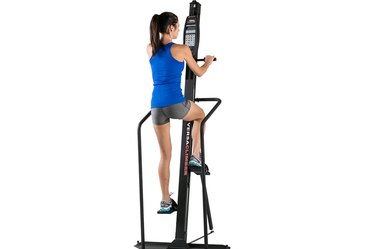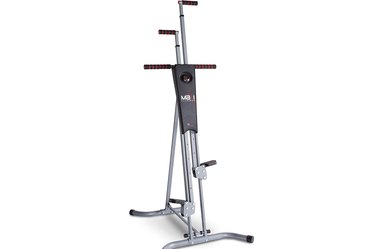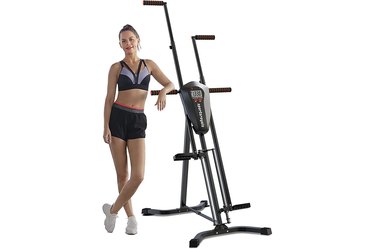
Take a look around your local gym and you're sure to find plenty of cardio machines: treadmills, stationary bikes, ellipticals and more. But if you're tired of all your go-tos, it might be time to mix it up by hopping on a vertical climbing machine.
While not new, the vertical climber — a tall, skinny machine with handholds and footholds — is a solid tool for boosting cardio as well as total-body strength by mimicking one of our most natural human movements: climbing.
Video of the Day
Video of the Day
Here's everything you need to know about vertical climbing machines.
What Is a VersaClimber?
Out of all of the vertical climbing machines on the market, none is more popular than VersaClimber. Originally launched in the 1980s, the brand rose to popularity in the mid 2010s when celebrities like LeBron James were seen sweating on one.
Then came Rise Nation, a nationwide VersaClimber fitness boutique created in 2015 by Jason Walsh, CSCS, CPT, that delivers 30-minute workouts to the masses.
"The climber allows us to apply a superior, primitive move that corrects and strengthens the body from pure movement," Walsh tells LIVESTRONG.com. "The move is demanding, recruiting every major muscle to coordinate and work together, which also requires more oxygen, and thus a superior conditioning workout."
Yet, it's also extremely accessible.
"Anyone with a hip or knee replacement — or just about any other issue that holds them back from taking most classes — all the way to elite athletes can take this class and benefit," Walsh says.
VersaClimber vs. MaxiClimber
While it's the most expensive brand of vertical climber on the market, "no machine matches the VersaClimber," says Walsh, who has tried them all.
There are alternatives to the VersaClimber, with the main competitor being MaxiClimber. MaxiClimber's machine is designed much more specifically for at-home use, with fewer bells and whistles than the VersaClimber.
How Effective Is a Vertical Climbing Machine?
Don't expect this (or any) machine to completely transform your body or your workout routine. But if you're looking for a change from your standard treadmill, elliptical or stair climber session, the vertical climber could be the perfect way to switch things up.
The machine uses a contra-lateral movement pattern (when your right arm goes up, your left leg moves down), which mimics a natural primitive pattern similar to crawling.
"With the high prevalence of sedentary jobs in the U.S., many Americans struggle with back pain, poor posture, a weak core, overly tight hip flexors and hamstrings and many other side effects from sitting in the same position daily. Crawling movements can greatly improve all of these areas," Brianna Frutchey, CPT, a coach at Jim White Fitness and Nutrition Studios, tells LIVESTRONG.com.
Expect to feel a bit awkward or uncoordinated your first time on a vertical climber. As Walsh explains, while climbing is something we learned as babies, it's not a movement adults use in their everyday life. So, your muscles (and more importantly, your brain) aren't going to be used to it from the get-go.
Also, because the vertical climber exercise machine requires your entire body to work together every rep, you'll likely feel your heart rate rise at a higher rate. You may feel out of breath or tired faster than you might on other exercise equipment. The best thing you can do as a beginner is to take it slow and easy. Focus on quality movements and getting comfortable on the machine before trying to increase the resistance on the machine or the speed of your effort.
Warning
Crawling motions may not be for everyone. Always check with your doctor before starting a new exercise routine, and stop any routine that is creating new or exacerbated pains.
"If an individual has any neck, wrist or shoulder complications — like carpel tunnel or arthritis — crawling movements or using a vertical climber machine may need to be put on hold," Frutchey says.
Vertical Climber Benefits
- Low impact: Because the machine doesn't require your body to leave the fixed footholds (similar to an elliptical or stationary bike), the vertical climbing machines provides a low-impact solution for people who can't take the pounding of running or HIIT classes. While you should always check with your doctor or physical therapist before starting a new routine, the vertical climber is typically safe for people with joint or back issues. (In fact, the upright position helps encourage healthy posture and alignment unlike other crawling modalities, Walsh says.)
- Total body: What muscles does a vertical climber work? Vertical climbers engage more muscle groups than pretty much any other piece of cardio equipment. The climber activates your lower body (glutes, quads, calves), upper body (lats, delts, triceps, biceps) and your entire core (especially your obliques).
- Time efficient: Vertical climber machines are self regulated, so you only go as hard as you're willing and able to push. Most workouts on a vertical climber are between 10 and 45 minutes. It can be used as a standalone sweat session (like Rise Nation class), thrown into a circuit or used as conditioning at the end of a workout.
- Brain booster: "Contralateral movements also require both sides of the brain to work, so crawling can help improve coordination and proprioception [the sense that helps us perceive where our body is in space and time] as well," Frutchey says.
How to Use a Vertical Climber
Walsh says getting to a fitness class that uses a vertical climber is by far the best way to work out on one. That's because classes typically teach you how to use the climber safely and effectively.
You can check with your local gym to see if they offer classes that integrate the vertical climber or if they have a trainer on staff who could take you through an introductory workout using the equipment.
For beginners who can't make it to a class and don't have a trainer at the gym who can assist them, Walsh recommends hopping on and trying to climb at different speeds, stroke lengths and/or distance and time.
How to Adjust a Vertical Climber
While each brand of machine will function slightly differently, here are a few tips to help you get started. (If you're at a gym but not in a formal class, we recommend asking a trainer to help you ensure you get everything set up correctly.)
- Before you start a session, make sure to adjust the machine to your height. For most machines, you'll do this by stepping on one pedal and moving the handles to the height of your shoulders. (Do this on both sides.)
- If the machine has adjustable tension levels (often displayed on the screen), use the number pad to set your desired level. Keep in mind that the higher the number, the more resistance you'll feel during your workout.
- Step into the footholds and securely strap in both feet. Grab both handles and begin by stretching your left leg and right arm up, then reverse with the opposite arm and leg.
Where to Buy a Vertical Climber
Experts recommend looking for a vertical climbing machine at your gym or search for a class in your area so you can test out a vertical climbing machine before purchasing one for yourself.
Once you're ready, these are three of the most recommended models for at-home gyms.
1. VersaClimber H/HP
The leader of the vertical climber revolution, this is one of the best vertical climbers on the market. This will be the most like the machines you'd find in gyms and boutique fitness classes.
Buy it: VersaClimber.com; Price: $3,195
2. MaxiClimber Vertical Climber
A far more affordable, stripped-down (read: no resistance levels) VersaClimber alternative, the MaxiClimber is designed for at-home exercisers. It comes 90 percent pre-assembled and includes a free fitness app where you can find workouts.
Buy it: Amazon.com; Price: $175.45
3. Sportsroyals Vertical Climber
Similarly minimal, this vertical climber is another popular at-home machine. Easy to set up, you can also fold it up and put it away to save space in your home when you're not using it.
Buy it: Amazon.com; Price: $189.99


